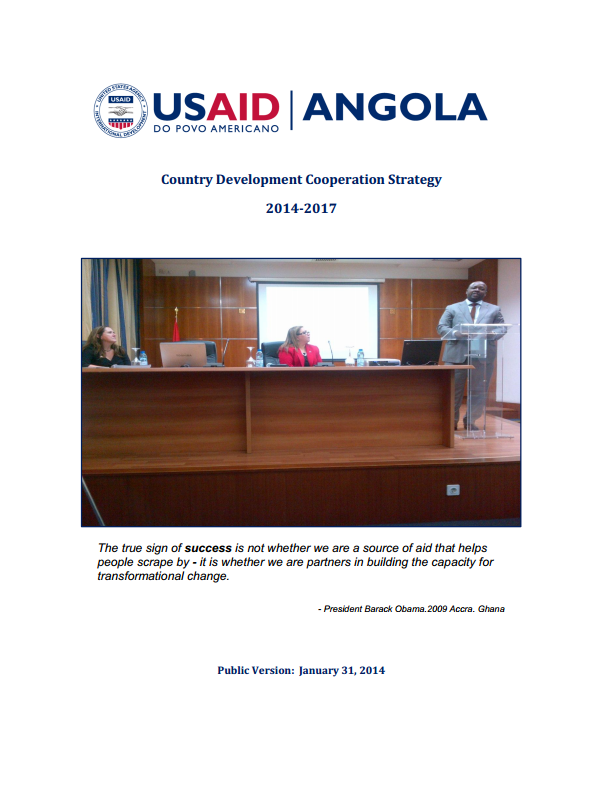The U.S. Agency for International Development’s (USAID) five-year Country Development Cooperation Strategy (CDCS) recognizes Angola’s growing economy, rising regional status, and remaining development challenges. As Angola emerges into the ranks of middle-income countries, it provides a genuine opportunity for USAID to begin a successful transformation of its relationship with this significant U.S. trading partner and important Southern Africa ally. This five-year strategy will chart the course for a transition from a donor/recipient relationship to one of development partners, where Angola will finance and manage its continued economic and social development with limited, catalytic technical assistance and direct engagement from USAID.
This CDCS signals the next phase of the U.S.-Angola development cooperation relationship and focuses on transforming the way in which USAID does business in Angola. During the next five years, USAID will respond to U.S. and Angolan priorities and challenges through a gradual transition to a new operational paradigm. USAID will directly engage with Government of Angola (GRA) counterparts, the private sector, and civil society to strengthen the ability of Angolan resources to meet the country’s development needs. As the GRA assumes more responsibility and competence in development planning and implementation, USAID's footprint will decrease. USAID expects the GRA to assume full responsibility for development planning and implementation with minimal USAID assistance at the end of the five-year strategy period. USAID will reduce its emphasis on traditional approaches that involve funding grants and contracts with international NGOs and contractors, and will increasingly focus on development partnerships among the GRA, the private sector, and local non-governmental organizations.
USAID engagement will be two-fold: the first will be increased catalytic technical assistance to government ministries involved in public administration, financial management, and other pillars of health system strengthening; the second will be an expanded effort to engage the private sector and civil society in reaching the country’s development objectives. To accomplish this transformation, USAID will continue to support the GRA’s own institution building initiatives by providing technical assistance, training, and supportive supervision in the larger health sector. At the same time, USAID will launch a reinvigorated public-private partnership (PPP) strategy using a “shared value” approach where partnerships center on the intersection of development and business objectives, resulting in the GRA and other national stakeholders finding and implementing solutions together. During 2000-2005, USAID/Angola was perceived as an Agency leader in PPPs, something of a poster child for successfully using such partnerships and alliances to great programmatic effect. USAID will play an integral role in this process by bringing innovative solutions to the table and providing facilitation as well as catalytic technical assistance for sustainable development. Consultations with the GRA over this transformative CDCS have revealed a mutual desire to partner in development as proposed herein.
Moving forward, USAID will capitalize on its investments in strengthening systems to ensure sustainable platforms are built that will manage, oversee, and operate basic health care and services, primarily for malaria, HIV/AIDS, family planning and maternal/child health. This CDCS will emphasize women and girls as the primary focus of HIV/AIDS, malaria, family planning, and maternal and child health programming. Meanwhile, USAID/Angola will continue the gradual transition from disease-specific service delivery models to a more comprehensive health service strengthening model in line with the National Health Development Plan (PNDS). USAID is successfully working with the GRA to increase its capacity and funding for commodities, and expects to be able to phase out of commodity procurement completely during the life of the CDCS. Resources will be focused on technical assistance and capacity building, critical to further the gains made in malaria and HIV, as well as systems strengthening which will allow both diseases to eventually be integrated throughout the public health system. A similar transition will take place in the area of Family Planning and Maternal/Child Health programming. Efforts will be concentrated on developing PPPs to increase the availability of quality commodities in the private sector and develop quality private sector service delivery.
This CDCS incorporates the objectives stated in the Presidential Policy Directive on Global Development and the Quadrennial Diplomacy and Development Review (QDDR) which emphasize sustainable outcomes, new operational models, and more effective partnerships. USAID/Angola’s new operational model will support Angolan leadership in the implementation of the GRA’s National Development Plan’s (PND) and National Development Health Plan’s (PNDS) strategies, with particular emphasis on investing in women and girls. The transformation of USAID’s operational paradigm in Angola will lead to more genuine peer-to-peer (P2P) engagement resulting in a substantial reduction in the overall program budget by the end of the CDCS period.
To reach the CDCS goal, USAID/Angola will place USAID Forward at the center of the strategy, by focusing primarily on local solutions through: establishing country-owned, public-private partnerships; transforming innovative financing mechanisms such as USAID/Angola’s Development Credit Authority program; and infusing catalyst innovations into national implementation plans that can be ‘game changers’ in terms of pace and impact of GRA development programs. Internally, USAID/Angola will continue to build and manage the talent of its Angolan staff, as they are best suited to analyze, stimulate and facilitate the development of local solutions with public and private stakeholders that lead to real sustainability and progress.
Read the full report [pdf]









Comment
Make a general inquiry or suggest an improvement.